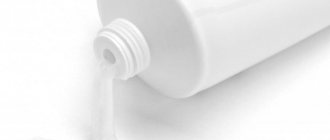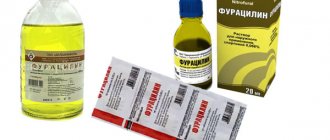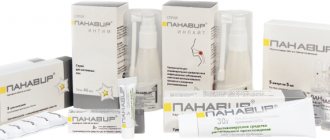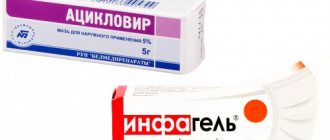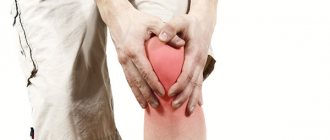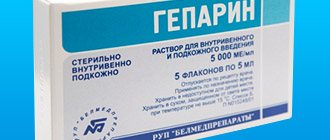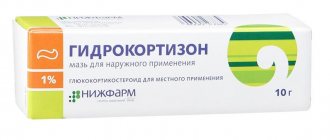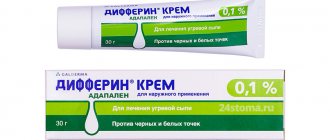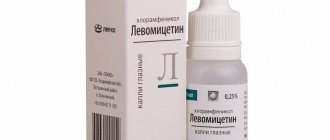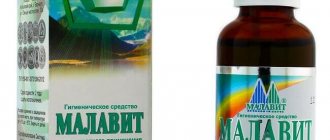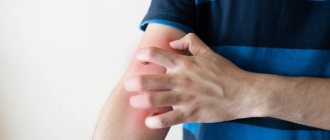Release form and composition of the ointment
The drug Ovestin is available in several dosage forms. This:
- vaginal ointment (15 g tube complete with applicator);
- suppositories;
- pills.
The main active component of the ointment and other dosage forms of the drug is the hormone estriol. The dosage of the hormone in the cream is 1 mg per 1 g of product. As excipients, Ovestin ointment contains:
- chlorhexidine hydrochloride;
- lactic acid;
- cetyl palmitate;
- polysorbate;
- octyldodecanol;
- stearyl and cetyl alcohols;
- glycerol;
- sodium hydroxide;
- purified water.
Attention! The drug is available in the form of a cream, however, experts often indicate Ovestin ointment in medical prescriptions. It is important to understand that in this case, cream and ointment are the same thing.
Properties
The drug is characterized by high bioavailability: estriol quickly and in high concentrations penetrates into tissues, providing maximum therapeutic effect at the site of inflammation. Also, the active component is absorbed in large quantities into the systemic bloodstream, evenly distributed in tissues and organs.
Estriol has a fairly short period of therapeutic action: removal of the substance from the body begins 2 hours after applying the cream and lasts 18 hours.
The ointment should be of uniform consistency, without various inclusions, have a white color and a specific smell. Before using Ovestin ointment for the first time, it is important to make sure that the physical properties of the cream correspond to those stated in the instructions for use.
If the characteristics are different (the ointment has a different color, inclusions, no odor), the drug may be a counterfeit, its storage conditions were not followed, or the expiration date has expired.
Pharmachologic effect:
Estrogen drug. An analogue of a natural female hormone. Replenishes estrogen deficiency in postmenopausal women and reduces postmenopausal symptoms. Most effective in the treatment of genitourinary disorders. With atrophy of the mucous membrane of the lower genitourinary tract, estriol helps normalize the epithelium of the genitourinary tract and helps restore normal microflora and physiological pH in the vagina. Increases the resistance of epithelial cells of the genitourinary tract to infections and inflammation, reducing complaints such as pain during sexual intercourse, dryness, itching in the vagina, reduces the likelihood of vaginal infections and urinary tract infections, helps normalize urination, and prevents urinary incontinence.
Unlike other estrogens, estriol has a short period of action, since it is retained in the nuclei of endometrial cells for a short period of time. It is assumed that a single daily dose does not cause endometrial proliferation. Therefore, cyclic administration of progestogen is not required and withdrawal bleeding does not occur. In addition, estriol has not been shown to increase mammographic density.
Therapeutic action and effects
Estriol has a positive effect on the female genitourinary system, namely:
- improves the functional state of epithelial cells of the mucous membrane of the urogenital tract;
- accelerates the regeneration (restoration) of the vaginal mucosa in the presence of atrophic changes in the tissues;
- maintains optimal pH level;
- normalizes the natural microflora of the vagina;
- suppresses the development of pathogenic microorganisms, preventing the development of genitourinary infections, increases local immunity.
Indications for use
Ovestin cream is used in therapy:
- age-related atrophic changes in the vaginal mucosa (dryness, thinning, impaired functional activity) occurring against the background of estrogen deficiency;
- atrophic colpitis;
- urological pathologies (frequent and/or painful urination, dysuria, urinary incontinence);
- infertility caused by cervical factor.
Ovestin is also prescribed for:
- prevention of the development of inflammatory processes in the urogenital area during menopause and postmenopause;
- diagnosis of a cervical tumor if the results of a cytological examination of a smear are not clear;
- preventing complications after gynecological operations.
How is pathology diagnosed?
Synechia in girls can be easily determined upon examination; the presence of pathology is indicated by the following signs:
- The labia are connected by a thin film of light gray color
- By spreading the labia apart, the girl experiences painful sensations, but the adhesion does not disappear anywhere
- Upon examination, the vagina is visualized as partially or completely closed.
Normally, when the labia are separated, a fairly large gap is observed; a detailed examination of the vagina can be performed.
Instructions for use
Ovestin ointment is introduced into the vaginal cavity using a special applicator once a day, usually before bedtime. The applicator allows you to dose the product correctly - a single dose of the main component is 500 mcg of estriol.
The frequency of use of the drug and the total duration of therapy are determined by the type and severity of the disease:
- To treat atrophic changes in the mucous membrane, it is usually recommended to use the ointment once a day for 4 weeks. Then the frequency of use is reduced to 2 times a week. The total duration of therapy is determined by the doctor individually.
- At the stage of preparation for gynecological surgery (to prevent the development of postoperative complications), the cream is started to be used once a day, every day, 2 weeks before the date of surgery. After surgery, the product is applied once every 3 days for another 2 weeks.
- If unreliable results of a cytological examination are suspected, the cream is recommended to be used once a day, every other day, for a week before the date of the diagnostic examination.
Important! Under no circumstances should the cream be administered twice a day, even if the previous application was missed.
Contraindications
Contraindications to the use of Ovestin in the form of cream, suppository and tablets are:
- hypersensitivity or intolerance to the main or one of the auxiliary components of the product;
- uterine bleeding of unknown origin;
- endometrial hyperplasia (pathological proliferation of tissues of the uterine mucosa);
- thromboembolism (clogging of blood vessels of the heart or pulmonary artery);
- sickle cell anemia (a hereditary disease characterized by a violation of the structure of hemoglobin, a change in the shape and properties of red blood cells);
- porphyria (hereditary disease characterized by a disorder of pigment metabolism);
- acute and exacerbation of chronic liver diseases, changes in laboratory parameters of liver tests, severe liver failure;
- hormone-dependent malignant formation of the mammary glands, tumor removal or suspected development of breast cancer;
- estrogen-dependent malignant tumors of the endometrium and other structures of the urogenital tract, suspicion of their development;
- period of pregnancy and breastfeeding.
How to use Ovestin cream
The hormonal agent Ovestin should be applied along the adhesion line, without affecting the genitals. The standard course of treatment with Ovestin usually does not exceed 2 weeks. (if the pathology has not been treated previously), treatment of adhesions is carried out twice a day.
After the course of treatment is completed, you will need to take the child for an examination to evaluate the results of hormone therapy. If necessary, a specialist may recommend continuing to use the cream, only now the ointment is applied to children once a day.
Treatment also involves the use of regular baby cream, which should be applied immediately after bathing.
At the final stage of treatment, it is recommended to gradually switch to a cream with lanolin; it will help prevent the development of re-adhesions.
Features of hormonal cream therapy
It is necessary to treat synechiae in girls taking into account a number of rules so as not to injure the mucous membranes of the external genitalia:
- You cannot remove synechia yourself by separating the labia minora.
- The ointment is applied in a thin layer, followed by rubbing in the areas where adhesions form.
- After the synechiae resolve, you will need to continue using an estrogen-containing product for prevention purposes.
Contraindications
Ovestin is a hormonal drug, so there are a number of contraindications to its use:
- Intolerance to drug components
- Presence of estrogen-dependent neoplasms
- Bleeding from the vagina of unknown origin
- Current or previous presence of thromboembolism
- Porphyria
- Active liver diseases
- Changes in liver test parameters.
Side effects
Ovestin cream is well tolerated, in rare cases it causes local reactions of irritation and itching. Even less often, during therapy, pain and tension and an increase in the size of the mammary glands are noted. Such effects, as a rule, occur in the first days of treatment with Ovestin, go away on their own over time and do not require discontinuation of therapy. If after a few days unpleasant symptoms persist, you need to consult a doctor to adjust the dose or replace the pharmacological drug.
Systemic adverse reactions when using Ovestin ointment develop extremely rarely, mainly during combination therapy with other estrogens and progesterone. The simultaneous use of several hormonal drugs can provoke the development of:
- cholelithiasis;
- benign (cyst, polyps) and malignant formations;
- dementia (mental disorder);
- vascular thrombosis;
- dermatological pathologies (chloasma, erythema, hemorrhagic purpura).
Important! In extremely rare cases, during treatment with Ovestin, serious adverse reactions were observed - spotting from the vagina, uterine bleeding. The occurrence of such reactions requires immediate consultation with a doctor.
Interaction with other drugs
During treatment with Ovestin, it is important to consider that the drug is absorbed into the systemic bloodstream and may enter into chemical interactions with pharmacological agents of other groups, including:
- anticonvulsants;
- antiretroviral drugs (used to treat HIV infection);
- antibacterial;
- vegetable, which contains St. John's wort.
Attention! Estriol enhances the therapeutic effect of hormonal corticosteroids and theophylline.
What else is important to know
During therapy with Ovestin ointment, it is important to consider the following points and follow the recommendations:
- Do not exceed the frequency of use and duration of therapy prescribed by the doctor.
- If long-term therapy is necessary, regularly undergo gynecological examinations, breast examinations, and take a coagulogram (blood clotting tests).
- If any adverse reactions develop, stop using the product and consult your doctor.
- In case of heart disease, arterial hypertension and renal failure, therapy with Ovestin should be carried out with caution, under medical supervision, since estriol can provoke fluid retention in the body.
- If hormone replacement therapy was carried out by other means, Ovestin can be used no earlier than a week after the last use of estriol-based medication.
Ovestin's analogues
If it is impossible to purchase an expensive drug, there are contraindications and restrictions, or adverse reactions occur after use, it is possible to search for an alternative - cheaper Ovestin analogues:
- Orniona;
- Ovipol Clio;
- Trioginal;
- Ovanelia;
- Estrovagin;
- Estrocad;
- Gynoflor E.
Prices for Ovestin and analogues in Moscow are presented for informational purposes only; they may vary in different cities and pharmacy organizations.
| Analogue | Price, in rubles | Manufacturer country |
| Ovestin tablets | 1150-1450 | Spain |
| suppositories | France | |
| cream | 1350-1700 | |
| Orniona | 650-1000 | Russia |
| Ovipol Clio | 550-750 | Russia or Republic of Moldova |
| Trioginal | 800-1100 | France |
| Gynoflor E | 650-900 | Switzerland |
| Ovaneliya | currently not available from suppliers | Russia |
| Estrovagin | 240-400 | Russia |
| Estrocade | 550-850 | Germany |
| Divigel | 600-900 | Finland |
Gynoflor E
A combined cheap analogue in suppositories, aimed at eliminating disturbances in the vaginal microflora and preparing for surgery. Contains estriol and lactobacilli acidophilus. Sold in pharmacies without a doctor's prescription.
Ovaneliya
An over-the-counter domestic drug based on estriol in the form of suppositories. Is a cheap generic or reproduction of suppositories.
Russian analogues are an opportunity to compensate for the lack of hormones at a lower cost.
Estrovagin
An analogue of Ovipol Clio, Estrocade and Ovanelia in the form of candles with a low price - up to 6-7 times cheaper. The difference is prescription.
Estrogial
The cream is an analogue of Ovestin, the price is up to 2 times lower (from 550 rubles). It contains sodium hyaluronate and a natural phytocomplex aimed at eliminating dryness, itching, and discomfort in the vagina. Reduces inflammation, irritation, deodorizes and heals. It belongs to the group of “Non-hormonal analogues of Ovestin cream”.
When choosing between Ovestin or Estrogial cream, it is better to buy the latter. Natural composition, fewer contraindications and side effects, inexpensive course of treatment - the advantages of the analogue.
Divigel
A cheap source of estrogen, it is a gel in two dosages in bags. Indicated in preparation for operations, to replenish hormones.
Analogs
The only structural analogue of Ovestin ointment (a substitute for a drug whose main component is estriol) is presented on the pharmaceutical market - Elvagin cream. The vaginal cream Kolpotrofin is similar in pharmacological action to Ovestin, but its main component is a synthetic estrogen analogue, promestriene.
Analogs of Ovestin ointment have the same therapeutic effects, indications and contraindications. The difference is in the manufacturer and price. However, you cannot replace the drug on your own, without the approval of your attending physician.
Ovestin is an effective drug that helps alleviate unpleasant symptoms caused by estrogen deficiency in the body, cure functional disorders of the genitourinary system, and prevent the development of complications after gynecological surgery. However, the drug has a lot of contraindications and can cause various adverse reactions, so it should not be used without a doctor’s prescription. As a rule, during menopause, Ovestin ointment is prescribed only in the presence of severe symptoms that significantly worsen the patient’s quality of life.
Orniona or Ovestin - which is better?
Orniona is a cheap substitute for Ovestin in the form of a cream, the price is up to 50% lower depending on the city and the chosen pharmacy. Contains estriol in the same concentration. The difference is in the country of origin. The analogue is a domestic drug for the treatment of diseases of women and conditions associated with estrogen deficiency. Also available without a prescription.
When choosing between Ornion or Ovestin, you can take any cream according to your financial capabilities and the preference of the manufacturer - foreign or domestic.
